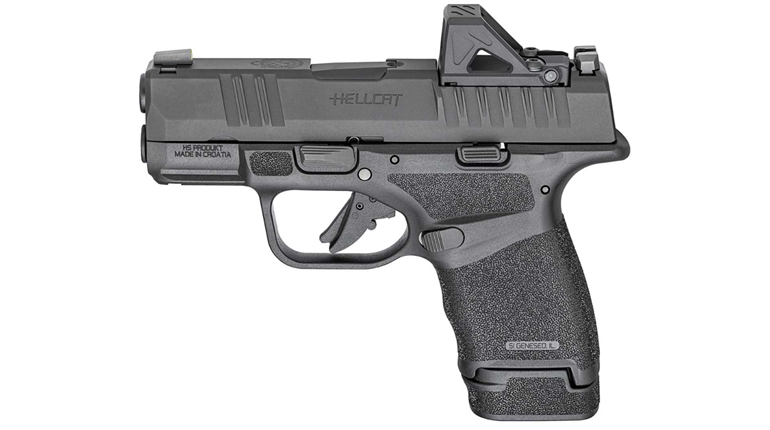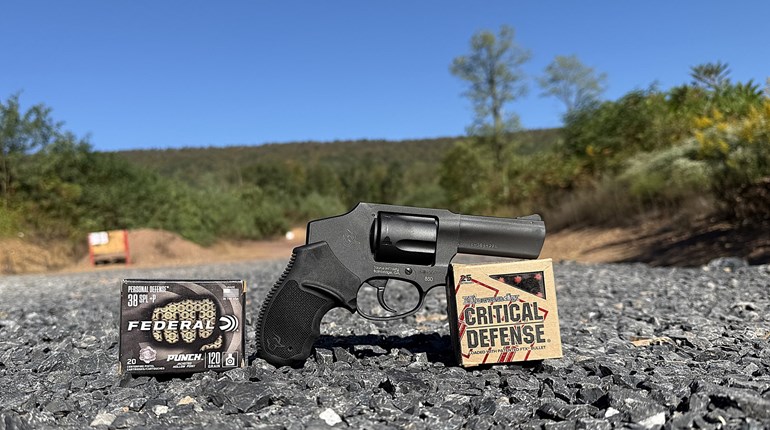
It’s the age-old question: Semi-autos or revolvers? The question has been asked and answered by many. The topic has been covered by firearms experts and enthusiasts across the board from the NSSF, to Personal Defense World, to American Rifleman, whose own B. Gil Horman wrote a great article on why you should choose a wheelgun. As a female shooter and shopper, I know that I want the reviews and opinions of a trusted source when researching a purchase as important as the firearm that I’ll use to defend myself or those I love. Many people simply speak to a family member or someone they trust, but for those of us without that luxury, we turn to the Internet—an endless chasm of “experts” spouting off on what you should or shouldn’t purchase.
Rather than listening to the ramblings of every Internet gun-nut or resigning yourself to the first hot-pink pocket pistol your boyfriend bought you, take it from these female experts. The following opinions are from a plethora of well-regarded female shooters and firearm experts in the industry, who have years of experience shooting, teaching or both. And once you’re done reading, you can go ahead and make up your own mind. Safe shooting!
Our Cast:
Julie Golob is an Army veteran, a hunter and a mother, but she is best known to the public for her competitive shooting career, winning women’s titles in seven different action shooting sports. If anyone knows about handguns, it’s this sharp shooter!
Barbara Baird is the publisher and editor of Women’s Outdoor News. She is also a freelance writer for numerous outdoor publications including Shooting Sports USA, Turkey Country, and, of course, NRA Family. Not only is she a great writer, but also has years of shooting (and teaching) experience under her belt as an NRA certified instructor.
Cyndi Flannigan is the VP of Marketing for Walther Firearms. An experienced shooter, Flannigan has been a longstanding board member of Youth Shooting Sports Alliance, Outdoor Recreation Heritage Fun and part of the Paralyzed Veterans of America group. She is also a longstanding NRA Benefactor.
Brenda Soucy, mother and grandmother, is the supervisor of customer service of Ruger Firearms. She has been with Ruger for 20 years, loves to shoot handguns, and enjoys the outdoors.
Now let’s get to the good stuff…
NRA Family: For a new shooter, what would you recommend—if you had to pick between a revolver and a semi-automatic pistol?
Julie Golob: I would most likely choose a semi-auto in .22 cal. for a new shooter. Even though the controls are more complicated and grip is especially important considering the moving slide, with proper instruction women can feel comfortable and confident with a semi-auto.
Barbara Baird: Either one. It depends on the woman's hand anatomy, strength and how much training she wants to devote to learning to use her new gun. Note: You must train with the gun you choose to carry—in low light, in daylight, in the dark, in the park, in the parking lot, on the ground, behind a barrier, from a tabletop. That is the only way you will be able to employ it when you need it.
Cyndi Flannigan: I would recommend that a new shooter go to a range that will allow them to shoot as many different guns as possible. The new shooter has to determine what they are comfortable with. Ladies will gravitate toward smaller guns, however that doesn’t always equate to something they are comfortable with once they shoot them.
Brenda Soucy: For new shooters, I usually recommend revolvers. A lot of folks are attracted to semi-autos because that is what they see on television, for example. While semi-auto pistols certainly have some advantages, they tend to be more complicated to operate. I believe that simpler is better for new shooters because simplicity allows the shooter to focus on safety, and not be thinking so much about how the firearm operates. I sometimes get questions from family members, and that is what I always recommend for new shooters. They can buy a semi-auto pistol once they are proficient at safe firearms handling.
NRA Family: Personally, which do you prefer?
Golob: I appreciate both platforms. I have more experience personally with semi-autos so I tend to lean toward them, but I carried a revolver for years and I have competed with them as well.
Baird: Both. In fact, I alternate between a Smith & Wesson 642 and several semi-autos. It depends on the type of clothing I'm going to wear.
Flannigan: I prefer a handgun that fits in my hand comfortably. I am comfortable with a 9mm or even a .45; however, all guns are not equal.
Soucy: I have learned to love both models. I personally started with revolvers, and was a little apprehensive the first time I shot a semi-auto. Since then, I have gained the assurance that comes with practice and training, so I guess I prefer pistols at this point. Though, I still love my revolvers.
NRA Family: What would you say is the best attribute offered on a semi-auto?
Golob: Semi-autos tend to have shorter and lighter trigger pulls. This is significant for those with smaller hands. Because of hand size and finger strength, some women really struggle with this and it can be discouraging, especially for a new shooter.
Baird: Smaller grip, single stack—for women's hands.
Flannigan: The best attributes are usually a good trigger and the number of rounds it could potentially hold, as well as a slide that is easy to rack.
Soucy: Magazine capacity and the ability to reload quickly. A lot of folks carry handguns for personal defense. The main advantage of semi-auto pistols in my opinion is that they tend to have higher capacities than revolvers and can be reloaded quickly. A spare magazine usually doesn’t take up much space. If I ever had to defend myself, God forbid, that additional capacity could make a big difference.
NRA Family: What would you say is the best attribute offered on a revolver?
Golob: Simplicity! Revolvers are easy to load and unload, and they are very simple to operate compared to semi-autos.
Baird: The internal hammer, so it doesn't snag.
Flannigan: Easy to load and fire; however, the trigger is usually very heavy to pull.
Soucy: Hmm … that’s a tough one. I think double-action revolvers are great. They are very simple to operate, and it really is a matter of point and shoot. You do not have to be as concerned about remembering whether the safety is on or off, whether there is a round in the chamber, etc. Revolvers tend not to jam as much as semi-autos can. Plus, I love the looks of the classic single-action revolvers and the way they feel in my hands: solid and comfortable. They remind me of the Old West and riding horses.
NRA Family: Women are often given gifts of small “pocket rocket” revolvers. What are your thoughts on these firearms vs. a small semi-auto like a .380?
Golob: J-frame revolvers vs. micro 9mm or .380 semi-auto pistols have their pros and cons. Both have a short sight radius, which makes them more challenging to shoot. The lighter the gun, the more the shooter feels the recoil, but it’s often not practical to carry a bigger or heavier gun. Ammunition selection is extremely important for small, light guns no matter whether they are a wheel gun or semi-auto. Soft-shooting practice ammo is extremely helpful for shooters of all ability levels to gain confidence with their shooting skills.
Baird: Please don't give any woman a gun unless she has expressed an interest in that gun and has tried it first. Never buy into the notion that because it's small and mighty, it'll work for her.
Flannigan: Again, I will continually push the fact that the new shooter, or any shooter for that matter, must be comfortable with the firearm they choose. Whether it is home protection or concealed carry. My friends laugh because I say it is like a pair of shoes: Which shoes do you grab out of the closet to wear first? The comfortable ones. I want a firearm that I know I have trained with, fits my body style, which I’m familiar and comfortable enough with that I can wear all day long. Small revolvers usually have heavy triggers, especially on the first pull and fewer rounds than a semi-auto pistol. The semi-auto pistol is usually more comfortable to shoot and more easily concealable.
Soucy: I think I would go back to the earlier question of pistols versus revolvers. If the shooter is new, the revolver may be the way to go. If they are more experienced, a pistol may be a better choice. It also may depend upon the grip strength of the individual. The slides on some pistols can be difficult to cycle by hand, particularly for folks with weaker hands. It is important that the person be able to operate the firearm safely and comfortably. Personally, I have both models and use them differently. My LCP is my choice for carry because of how compact and easily concealable it is. My LCR is my home-defense handgun. Each person must decide which is right for them and, like me; it may depend on the circumstances.
NRA Family: For someone with small children, which would you recommend in terms of safety features?
Golob: Firearms should be locked up when not in use and no matter the platform, a gun owner needs to maintain control of their firearm. Revolvers tend to have heavier triggers, which help prevent small hands from shooting a firearm. External safeties on semi-autos can also help prevent accidental firing, but safe storage procedures and responsible ownership are the most important aspects with regard to gun safety and children.
Baird: Always know where your "ready" gun is, and if that means in a locked case or compartment, so be it. If you don't want your gun to be in a "ready" state, then by all means, unload and store it in a locked safe or case, away from ammo.
Flannigan: The firearm should never be anywhere near a child that might have access. The rule here is all guns are loaded and you must teach your children as such. Locked in safes, etc. Also, depending on the ages of the children, I would teach/enroll them in firearms safety, like the NRA Eddie Eagle Program or other good programs for youth shooters.
Soucy: I don’t know that my recommendation changes because, pistol or revolver, it doesn’t matter—the firearm should be absolutely secured or in your control at all times. Ruger provides gun locks with every firearm, as do most other manufacturers these days. Folks need to keep all firearms safe and secure, period.
NRA Family: On a scale of 1-10 for reliability, what would you give the semi-auto? The revolver?
Golob: Revolvers get a 10. They rarely ever malfunction due to the simple design. Semi-autos can malfunction and do require more maintenance and upkeep, and because of that I’d designate a 9. If you’re not willing to clean, maintain and keep track of parts changes on a semi-auto, it might not be the right choice for you.
Baird: Of course, the revolver will not malfunction as a semi-auto would, but again, if you train, you should be able to clear the malfunction and carry on.
Flannigan: For reliability I give both a 10.
Soucy: The revolver? That’s a tough one also. It really does depend. If properly serviced and maintained, both should provide years of reliable service. That said, my experience has been that semi-auto pistols tend to be more prone to jamming, for example, simply because of all the added complexity of magazines, feeding, slides cycling, etc. I would have to give revolvers a slight edge for reliability.
NRA Family: On a scale of 1-10 for quick handling, what would you rate the semi-auto? The revolver?
Golob: Both are equal here at 10. Training and practice are key no matter the platform.
Baird: 10 and 10—this is really the operator's responsibility.
Flannigan: For quick-handling, I give the semi-auto a 10, and the revolver a 9.
Soucy: I’ve seen some folks handle revolvers faster than I can handle anything, regardless. That said, revolvers tend to be larger and a little more cumbersome. They do not holster or unholster as smoothly and are difficult to fire as rapidly as a pistol. I would have to say pistol: 9; revolver: 6. Again, it will depend on the shooter … I suspect S.A.S.S. shooters might disagree.
NRA Family: On a scale of 1-10 for best concealed-carry gun, what would you rate a semi-auto? A revolver?
Golob: Concealed carry is a personal choice. Revolvers generally have less capacity and a long double-action pull. Semi-autos require more upkeep and are more complicated to shoot. Both are excellent choices for personal protection. The best choice for a carry gun comes down to what you feel most comfortable and confident with.
Baird: 10 and 10.
Flannigan: For the best overall concealed-carry gun, I give the semi-auto a 10 and the revolver an 8. All firearms are reliable, quick and concealable. Training and going to the range often will determine your familiarity and comfort level. My strong belief for anyone interested in wanting to take control, or to defend their family and themselves is to always take a course before purchasing. In most cases, even the newest of shooters don’t know what they want. Their friends, husbands and even the guy behind the counter insist they purchase “XX.” Put your hand on every gun model and style you can. Then sign up for a class and learn safety, shoot several different guns including revolvers, firearms with lasers, large-frame guns, small-frame guns, .380 caliber, 9mm, etc. These choices are very personal.
Soucy: My choice for concealed carry is a pistol because of the compact size, capacity, ease of reloading, variety of holsters, etc. I would give the pistol the edge with a 9, probably a 7 for revolvers
Feel free to share what your preferred firearm of choice is—or do you carry both depending on the situation?







































